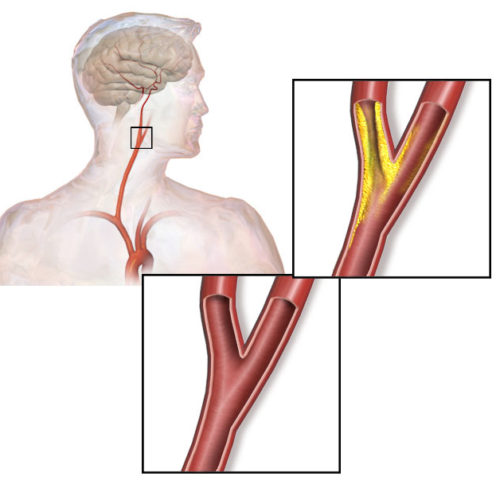
Carotid artery disease is a condition in which fatty deposits or plaque forms in the carotid arteries. These are the two main blood vessels that bring blood to the brain; they start from the aorta in the chest and travel up towards the neck and then into the brain. When too much material blocks these arteries, they can be come narrow and increase a person’s risk of having a stroke.
What are the symptoms of carotid artery disease?
Carotid artery disease does not always cause symptoms, but as the narrowing worsens, the disease can cause stroke or transient ischemic attack (TIA), both very serious conditions.
Stroke occurs when blood flow to an area of brain is cut off. Brain cells are deprived of oxygen and begin to die. When brain cells die during a stroke, abilities controlled by that area of the brain — such as memory and muscle control — are lost.
Symptoms of stroke may include weakness or loss of sensation of one side of the body, drooping of one side of the face, loss of vision or inability to speak or understand speech etc. Some people recover from strokes without lasting effects or with only minor problems.
Transient ischemic attack is essentially a stroke but one that lasts only a short time and from which patients generally recover within 24 hours. These attacks do not cause brain damage but must be recognized and treated, because people experiencing TIA are at very high risk of having a full-blown stroke.
Carotid artery disease can lead to TIA or stroke, because blood clots or plaque can come loose and travel inside the narrowed artery to the brain. Other causes of stroke include narrowing of the arteries in the brain, bleeding from rupture of the arteries in the brain or clot or plaque traveling to the brain to clog the artery.
How is carotid artery disease diagnosed?
Doctors can listen to each carotid artery with a stethoscope to hear a “bruit’ or a swishing sound that would suggest a narrowing. However, this is not always accurate and hence additional tests need to be performed, such as:
- Carotid duplex ultrasound – Simple ultrasound test to detect narrowing of the arteries in the neck.
- Computed tomography angiography (CTA) — Uses X-ray radiation and dye to take images non-invasively.
- Magnetic resonance angiography (MRA) – Uses magnet-based technology with special dye to image the arteries and surrounding areas.
- Carotid Angiogram — This is an invasive test that requires specialists to inject dye into the arteries directly and take images to diagnose and in some cases open the arteries.
How is carotid artery disease treated?
Treatments for carotid artery disease depends on the severity of narrowing of the arteries with a goal to prevent strokes. Treatments can include:
Medicines – In general, the medicines that can help prevent strokes and help in patients with carotid artery disease include drugs that lower blood pressure and cholesterol (called statins) and those that thin the blood, such as aspirin.
Surgery – Doctors can perform a surgery called “carotid endarterectomy” to remove plaque from the carotid arteries when the arteries are significantly narrowed (often over 80% narrowed).
Carotid stenting – Carotid stenting is a less-invasive procedure than surgery. This procedures involves the insertion of a tiny metal mesh called a “stent” to prop open the carotid artery. Doctors often use a tiny basket above the narrowing to prevent plaque from traveling to the brain.
Lifestyle changes –
Irrespective of the above treatments, people must follow these recommendations to reduce their risk of stroke:
- Quit smoking (if applicable)
- Maintain physical activity
- Lose weight (if overweight)
- Eating a diet low in fat and cholesterol and high in fruits, vegetables.